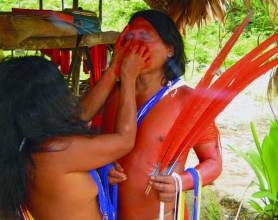簡介
瓦傑皮人的口頭和圖畫表達形式區域:巴西 類別:民間文學 瓦傑皮人的口頭和圖畫表達形式 於 2003年 被列為代表作
 瓦傑皮人的口頭和圖畫表達形式
瓦傑皮人的口頭和圖畫表達形式說圖皮-瓜拉尼語的瓦傑皮人居住在亞馬遜河北部地區。現在有580多瓦傑皮人,他們居住在巴西東北部阿馬帕州保護區的40個小村子裡。瓦傑皮人用植物顏料作為裝飾的歷史相當長久,他們在身上和其他物體上畫幾何圖形。經過許多世紀的演變,他們發展了一個獨特的交流形式 –有豐富的圖形和口頭表達形式 – 能反映他們的世界觀,並能傳承他們的知識。
這種圖形藝術被稱為“庫西瓦”,使用從胭脂樹提煉出來的黃紅色顏料和芬芳樹脂混合繪製美麗圖案。瓦傑皮人認為要繪製這些圖案,不但要有熟練的技巧,而且還要精通藝術。也就是說他們不但要有高超的繪畫技巧,還要精通顏料的配置。一般人在40歲之前是不可能達到的。常見的圖形有美洲虎、水蟒、蝴蝶和魚類。這些圖案反映人類的誕生,並栩栩如生地展示了以人類起源為主題的各種神話。
儘管瓦傑皮人居住在保護區內,但他們的傳統生活方式,包括“庫西瓦”,仍然面臨著失去原有意義乃至消亡的威脅。這會給該地區的社會觀和宇宙觀帶來巨大變化。主要的威脅來自於年輕一代對這門藝術不感興趣;以及現在精通“庫西瓦”的藝術家的老齡化和數量的減少。
The Wajapi of the Tupi-guarani cultural-linguistic group are indigenous to the northern Amazonian region. Some 580 Wajapi live in 40 small villages on a specially designated territory in the state of Amapá. The Wajapi have a long history of using vegetable dyes to adorn their bodies and objects with geometric motifs. Over the centuries, they have developed a unique communication system – a rich blend of graphic and verbal components – that reflects their world-view and enables them to hand down knowledge about community life.
This graphic art is known as kusiwa and its designs are applied with red vegetable dyes extracted from the roucou plant mixed with scented resins. The Wajapi consider that the technical and artistic proficiency required to master the drawing technique and the preparation of the dye cannot be attained before the age of forty. Commonly recurring motifs include the jaguar, anaconda, butterfly and fish. Kusiwa designs refer to the creation of humankind and come alive through a rich Corpus of myths.
Although the Wajapi live on their protected territory, their traditional lifestyle, including the practice of kusiwa, is in danger of losing its symbolic significance and may even disappear altogether. Such a loss would drastically alter the community’s social and cosmological reference points. The principal threats stem from disinterest on the part of the younger generation and the decreasing number of Wajapi proficient in the kusiwa repertory.
